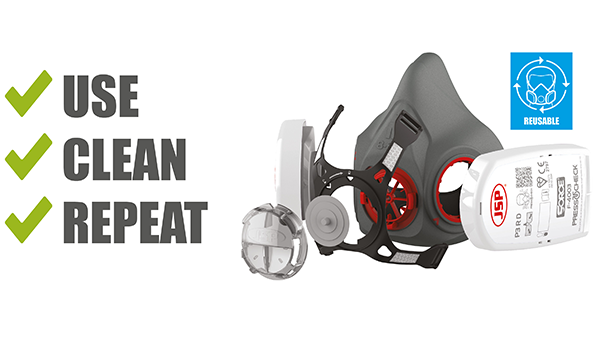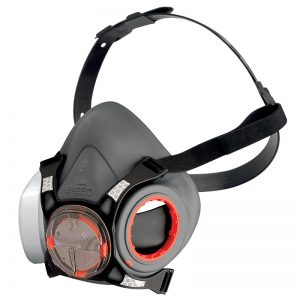JSP Force®8 reusable mask - Cleaning and maintenance
 An effective maintenance system for respiratory protection products is essential to ensure that the equipment continues to provide the intended level of protection. Maintenance includes cleaning, inspection, replacement, repair and testing.
An effective maintenance system for respiratory protection products is essential to ensure that the equipment continues to provide the intended level of protection. Maintenance includes cleaning, inspection, replacement, repair and testing.
WHY YOU SHOULD CLEAN AND MAINTAIN A HALF MASK?
Information on proper maintenance of the mask can be found in the accompanying user manual, and additional information can be obtained from the manufacturer. Cleaning, maintenance and storage requirements may vary by product, so it is important to check the instructions for each respirator. Replacing worn or faulty parts and keeping the equipment clean will help ensure protection and extend the life of the product. 
CLEANING AND MAINTENANCE EXTENDS THE LIFE OF THE PRODUCT
Half masks and full face masks with replaceable filters provide long-lasting protection of disposable respirators. Proper maintenance is important to ensure optimal performance and maximize equipment life. The instructions that come with the product detail how to clean and maintain it safely. The appropriate way of cleaning and maintenance ensures the necessary hygiene, helps to reduce costs, but also contributes to sustainability.
REUSABLE BENEFITS
The use of reusable masks for the protection of the respiratory organs enables the reduction of costs and waste, compared to the use of disposable products and masks with integrated filters. In addition to offering greater comfort and a better fit, reusable respirators can be used for several years. They are easy to clean and maintain, and the filters can be replaced at the end of their useful life.
HOW TO CLEAN AND MAINTAIN A HALF MASK?
JSP's high-quality, innovative respiratory protective equipment is developed and tested in a dedicated quality assurance laboratory, ensuring superior performance levels are achieved and maintained. The Force®8 and Force®10 JSP masks are designed and manufactured to be fully user maintainable. These products can be disassembled for cleaning, so users have respiratory protection that they can actually reuse. The product can then be stored in the original packaging or in additional PPE packaging to ensure that no contamination of the product occurs between uses. You can watch a cleaning and maintenance video for the Force®8 half mask below: [embed]https://www.youtube.com/watch?v=s13lbaWBKOM[/embed] Users who follow this method of use will ensure a long-lasting, sustainable and cost-effective life cycle of respiratory protection products. PLUS TIP: Putting on and taking off these products should be done in a clean environment to avoid contamination before and during use.
JSP Force 8
 The JSP Force 8 half-mask is made of light, flexible and durable thermoplastic rubber, and the suspension is at 4 points - this makes it fit perfectly on the face and thus achieves an excellent seal. It features two replaceable low-profile bayonet filters (manufactured in accordance with EN 14387, EN 140 and EN 143 standards), which minimize the field of view and a Typhoon™ exhaust valve with minimal breathing resistance. A special innovation in the bayonet filters used by this mask are the Press-to-Check™ filters, which, thanks to a revolutionary design, allow workers to quickly and reliably check for optimal sealing before entering a zone of increased risk. It is used in the chemical and petrochemical industry, in the production of fertilizers, in laboratories, medicine, pharmacy, agriculture, construction and in performing all tasks that require appropriate protection of the respiratory organs. The Albo company range includes JSP products for the protection of respiratory organs. At Albo you can find the Force 8 half mask and corresponding filters, which are intended for protection against different types of particles, gases and steam. When choosing the best means to protect the respiratory organs, it is necessary to be careful with regard to the identification of contamination, that is, the selection of filters. The Albo team is at your disposal for all assistance and additional information in the selection of protective equipment.
The JSP Force 8 half-mask is made of light, flexible and durable thermoplastic rubber, and the suspension is at 4 points - this makes it fit perfectly on the face and thus achieves an excellent seal. It features two replaceable low-profile bayonet filters (manufactured in accordance with EN 14387, EN 140 and EN 143 standards), which minimize the field of view and a Typhoon™ exhaust valve with minimal breathing resistance. A special innovation in the bayonet filters used by this mask are the Press-to-Check™ filters, which, thanks to a revolutionary design, allow workers to quickly and reliably check for optimal sealing before entering a zone of increased risk. It is used in the chemical and petrochemical industry, in the production of fertilizers, in laboratories, medicine, pharmacy, agriculture, construction and in performing all tasks that require appropriate protection of the respiratory organs. The Albo company range includes JSP products for the protection of respiratory organs. At Albo you can find the Force 8 half mask and corresponding filters, which are intended for protection against different types of particles, gases and steam. When choosing the best means to protect the respiratory organs, it is necessary to be careful with regard to the identification of contamination, that is, the selection of filters. The Albo team is at your disposal for all assistance and additional information in the selection of protective equipment.


